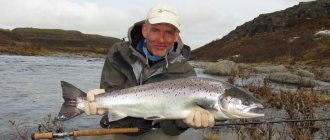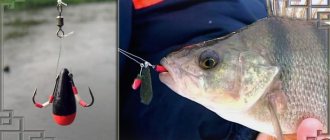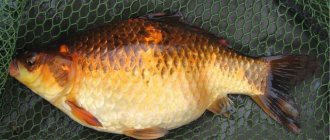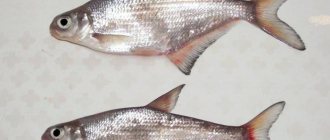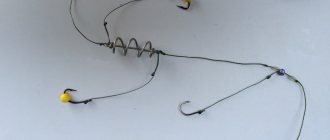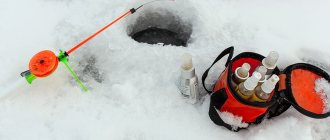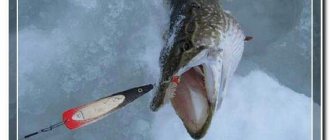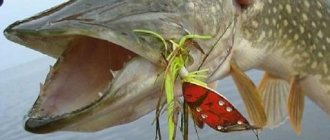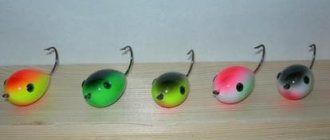Story
Devons
It is believed that Devons appeared at the turn of the 18th and 19th centuries in the British Isles and were one of the first, along with oscillating spoons, lures for spinning fishing. Actually, they owe their name to the county of Devonshire, or Devon for short. There is probably not as much asp in Great Britain as we have in the Lower Volga, so initially the Devons were focused on catching salmon on the rapids.
According to historical sources, the first Devons were wooden, and therefore floating. I don’t know how the British, with their literally “sticks” of hickory and bamboo and silk cords of that time, managed to cast such a lightweight bait, I don’t know, however, the historical fact is obvious. Then Devons began to be made from mother-of-pearl, and later from metal.
The British are traditionally strong in their canons, so it is not surprising that practically the only one in the world that still produces laminated bamboo rods also produces Devons, including mother-of-pearl ones.
In Russia, the Devons flourished around the 30-50s of the last century, at least this is what one can assume when reading the books of Laputin and Sabanaev.
In subsequent years, there was little information about the Devons, only wandering from one reference book to another reprint of the same Sabaneev. The domestic industry did not pamper spinning players with Devons, occasionally giving birth to innovative models made of rubber-like plastic (they, by the way, were not so bad with appropriate modifications), or completely non-functional copies of the Devon of the Swedish company ABU with a fixed axial load.
Classification
According to the location of the blades:
- At the head. Promotes the movement of the spoon to the surface of the water. Often this movement attracts asps.
- In the central part. The depth of the Devonian depends on the speed of conduction.
- In the tail section. Practice shows that this design is less efficient than the previous ones.
- Smooth - a torpedo-shaped streamlined body.
Faceted - the body is also torpedo-shaped, but behind the propeller there are carved edges that create highlights when moving in the water, reminiscent of the play of scales.

Flat - an elongated flat body with blades on the sides.
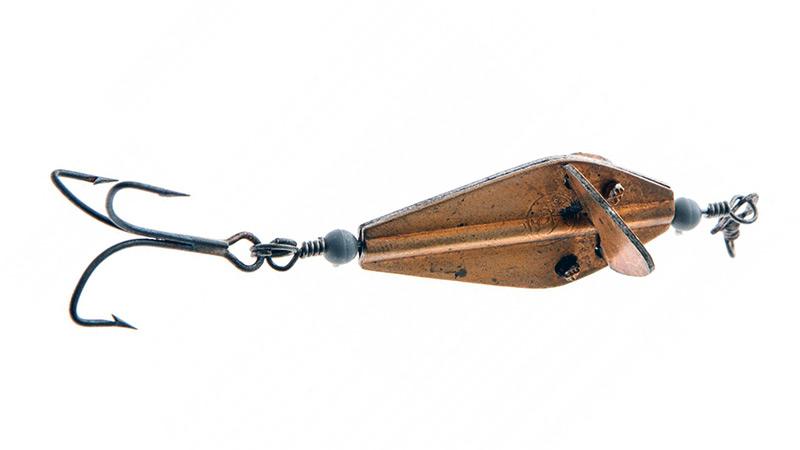
- tee in the tail section;
- a tee in the tail section and one or two tees in the central section.
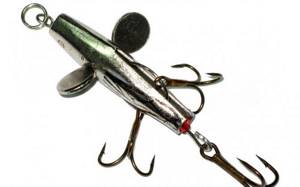
By weight and length:
Small Devon “mosquitoes” weighing 5-6 g and 28-30 mm long are designed for catching small predators in the upper water horizon, mainly small perches. Semi-predatory fish species can also covet such a light lure, since the Devonian, when retrieved, resembles a fry, which semi-predatory fish do not disdain.
The larger Devon "Cyclops" weighing up to 8 g and 30-40 mm long will interest both small and larger predators. It is especially effective in fast currents.
“Bumblebee” - Devonian weighing 8 - 14 g and up to 48 mm long - universal. During currents and in still water, it effectively attracts all predators – perch and pike in still water; pike perch, asp, chub, grayling in fast currents. It also comes across trophy specimens.
Devon 15-21 g, about 50 mm long, was called “meteor” . Designed for long-distance casting, especially necessary when catching fast, but cautious and big-eyed asp.
Heavy and large Devon “phantoms” weighing from 25 g to a length of 56 mm are designed for working at depth. Very effective when fishing boilers. Capable of attracting trophy specimens.
Super-heavy Devon “gliders” weighing from 32 grams are used for long casts from the shore into explored holes and barrels. They can provoke an attack by catfish and other predatory inhabitants of the depths.
Devonian design
Among spinning anglers, Devon is a spinner with a hollow metal body that is cigar-shaped. In the front part of the bait there are two blades rotating on an axis in opposite directions. During retrieval, this design causes a powerful vortex in the area of the bait, which attracts the attention of the predator.
The device of the Devon can be called quite simple. In modern conditions, it is not difficult for many fishing lure makers to make their own model. The main elements of the Devonian are:
- spinner body;
- blades;
- kernel;
- hook;
- swivels, anti-twisters, beads, etc.
The body of the Devon is cigar-shaped with an axial hole and is made of brass, tin or copper. A wire rod is passed through the formed channel. A hook is attached to it at the back, and rotating elements are installed at the front. A bead is mounted between the blades, which prevents the propellers from approaching each other during mutually opposite rotation. The front end of the wire is bent into a ring, thanks to which the Devon is connected to the main fishing line through a swivel and a carabiner.
Fishing rods (types, equipment)
There are three main types of fishing rods, float, spinning, and fly. Each species has its own equipment and individual fishing conditions.
A float fishing rod is the simplest fishing rod; it is not difficult to make with your own hands. This fishing rod does not even require a reel; a reel for winding the fishing line is completely sufficient in this case.
The fishing rod consists of the following elements:
- Rod;
- Fishing line;
- Float;
- Sinker;
- Leash with hook.
It is better to make a fishing rod from walnut, a goose feather can serve as a float, and a nut can be used instead of a sinker. You will be surprised, but this design will actually work. Unfortunately, the catch will be small as the fish stocks in our rivers are not as plentiful as they once were.
Fly fishing is an improved float fishing rod that has a reel, bait and a special fishing line. Fly fishing is mainly used for catching fish in the middle, which feed on midges and beetles and various insects. This method of fishing does not involve the use of a float and sinker.
Spinning is the most modern tackle, which uses all available fishing methods. One of the main parts on a spinning rod is the reel; sometimes the price of the reel exceeds the cost of the rod with all the bells and whistles.
The main fishing technique using a spinning rod is to cast bait over long distances.
The spinning rod is made of solid plastic, but there are models made up of several parts. The edges are finished with stainless steel rings.
The spinning rod uses a special handle made of wood, plastic or cork. The length of the handle reaches 70 cm. Spinning is the leader in catching predatory fish such as pike, perch, asp and others.
Advantages of Devon
- The compactness and streamlined nature of the bait as a whole ensures long-range and extremely accurate casting, which is especially important if you need to “get” fish from a long distance.
- Stability and high rotation speed are guaranteed by the turbine blades.
- The combination of the streamlined shape of the bait and the drag of the blades helps the Devon easily rise to the very top layers of the water, while even with a heavy Devon it is easy to carry out furrowing along the surface itself, or even even with a stroke along the crests of the wave.
- The rapidly rotating blades provide a breaker that is clearly distinguishable both visually and audibly. The active noise of the bait generally greatly irritates the predator and attracts it from a great distance.
- Devon works great in tandem with a fly attached 20-30 cm above on a separate short leader. The stalking effect actively provokes the predator to attack.
- Experienced spinning anglers who have thoroughly mastered Devon fishing know that this bait is attractive not only for asp. Chub, ide, grayling, salmon, lenok, taimen, trout and even deep-sea predators - pike perch and large perch will not miss a bait that is correctly selected in size, color and correctly presented.
- A properly made Devon rotates at any stage of the drive, and even during free fall. Therefore, it is quite possible to use stepped jigs for fishing both in the water column and at the very bottom.
Wobbler for asp
A modern bait - a wobbler, in appearance resembles a small fry, for the manufacture of which it uses polymer. There may be one or two hooks in the tail of the wobbler. Having chosen the right model, color and diving horizon, the effectiveness of such a bait will surpass any spoons, spinners and silicone. Hooks with such bait on asp occur extremely rarely, since fishing is carried out in the upper reaches of the reservoir.
We select the color of the wobblers in accordance with the color of the main asp prey in the pond in question. When the asp feeds mainly on bleak, we choose a light-colored wobbler, or it is better to replenish the arsenal with several shades and shapes of bait. Zip Baits Rigge wobblers are perhaps the best bait for catching asp on a spinning rod; they are easy to fish with in slow and medium currents in accordance with a given horizon.
In addition to the considered baits, jigs, animal baits, vegetable baits, silicone and live bait work well for asp. In winter and autumn, it’s time to switch to live bait or a “bun” spoon, which you make yourself.
TAGS:
Disadvantages of Devonian
- The main disadvantage of Devons, according to the overwhelming majority of anglers, is their amazing ability to twist the line in just 3-4 passes and turn it into a “pig tail” along its entire length. The disadvantage is significant and can sometimes easily cancel out all the advantages.
- Global manufacturers practically do not mass-produce these spinning baits. This is why handicraft production flourishes, which does not allow the creation of high-quality models.
- Devons, created under modern production conditions, scare away fishermen with high prices. Even Russian baits are offered in stores for 500-700 rubles.
Devon fishing
Fishing with a Devon requires certain skills, including sports ones, so not all novice fishermen are up to the task.
Casting Devonian
Devon fishing The main condition for successful fishing is the ability to accurately cast the bait and correctly guide it at the required depth (in some cases, almost at the very surface of the water).
In order to become a successful fisherman and acquire the necessary skills, it is advisable to first practice on land. It is best to conduct classes on a flat area or lawn. Before starting training, you should place targets in the form of plywood circles at different distances from you (10.15 and 25 m). You can also use regular newspaper sheets. You should learn to hit these targets with small weights comparable in weight to real bait.
Of course, the weight used for exercises should not have a hook. After systematic training, accurately throwing a Devon into the water will no longer seem so difficult.
Having practiced well, you can start throwing bait into the pond. By the way, the acquired skills will be useful not only when accurately throwing into the water. Sometimes, for example, when fishing for pike and perch, you need to throw the bait near the grass and then carefully move it along. The fact is that these fish are often in the grass as if in ambush, waiting for a victim to swim by.
Therefore, by throwing the bait into the grass, you can count on getting a hook. Accurate casting and correct wiring are the main conditions for the success of any fishing.
Devon wiring
The main task is to keep the wiring horizon stable. If, when casting with a uniform retrieve, there is no bite, we make the next cast to the same place, but the retrieve should be stepped (but not classic, when the bait reaches the bottom, but pelagic). The “step” needs to be quite wide, about 1.5-2 m. The wiring horizon is the same, at a depth of 2-3 m.
If in this case there is no bite, we make the next cast a little lower, closer to the “boiler” and also perform first a uniform and then step-by-step casting. Unlike fishing with jig baits, when using Devons in a stepped retrieve, the bite occurs in 90-95% of cases during reeling and only in 5-10% during a pause.
A bite, as a rule, is felt as a sharp blow, although not as powerful as when fishing “from above.” We are gradually approaching the “cauldron”. In order not to attract the attention of small specimens hunting on the surface, the casts should throw the “fight” tens of meters, and then the wiring proceeds as mentioned above. The most productive area in terms of captured specimens is below the “battle.”
DIY Devon. Necessary materials
Devons are quite rare for sale. Therefore, sometimes fishermen make them themselves from cold-hardening plastics. These materials are best suited for making baits at home.
Some of these types of plastics are used in dental practice. These include rhodont, steracryl, protocryl, noracryl and stadont. Also, to make bait, you can use plastics that are used in industry - acrylate ASG-T, styrakryl TSh.
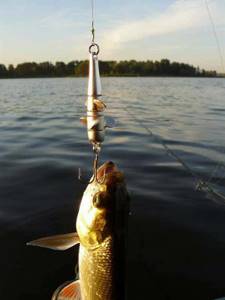
3 ways to improve your fish bite!
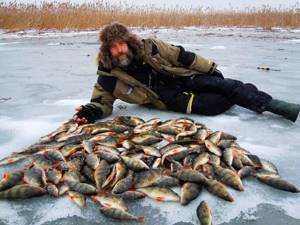
Over 15 years of active fishing, I have found many ways to improve the bite, and here are the most effective:
1. Bite activator . This pheromone additive attracts fish most strongly in cold and warm water. The Fish Hungry bite activator has proven itself to be excellent - Read more…
2. Tackle with increased sensitivity . You should first familiarize yourself with the features of using a particular type.
3. Pheromone baits . They attract the attention of fish, stimulate hunger and cause a schooling reflex, which allows you to collect a lot of fish in one place.
You can get the rest of the secrets of successful fishing for free by reading my other materials on the site.
3 ways to improve your fish bite!
Over 15 years of active fishing, I have found many ways to improve the bite, and here are the most effective:
1. Bite activator . This pheromone additive attracts fish most strongly in cold and warm water. The Fish Hungry bite activator has proven itself to be excellent - Read more…
2. Tackle with increased sensitivity . You should first familiarize yourself with the features of using a particular type.
3. Pheromone baits . They attract the attention of fish, stimulate hunger and cause a schooling reflex, which allows you to collect a lot of fish in one place.
You can get the rest of the secrets of successful fishing for free by reading my other materials on the site.
The method of use of these materials is usually indicated on the packaging or in the accompanying instructions. The casting method is used to produce plastic Devon.
The casting mold is pre-cast from plaster mixed with wood glue in a wax or wooden model. Before casting, the mold is dried and lubricated from the inside with wax or paraffin.
Not all Devons can be made from plastic. For example, a metal tube is most often used to make cylindrical baits.
